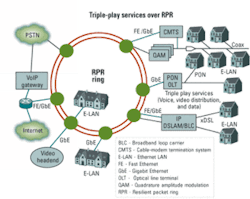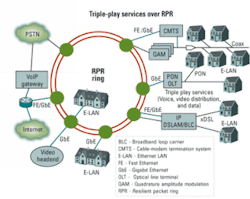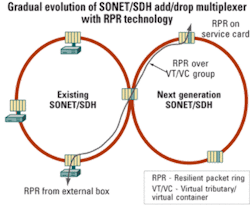RPR supports efficient Ethernet data traffic in metro networks
Several service providers see resilient-packet-ring (RPR) technology as a key part of their strategies. RPR, a Layer 2 standard from the IEEE, enables service providers to build more scalable and efficient metro networks using SONET/SDH or Ethernet as physical layers for the provision of triple play services (see Figure 1). It is based on an efficient double-ring topology and supports fast recovery from fiber cuts and link failures. RPR can provide the bandwidth efficiency, simplicity, and cost advantages typical of Ethernet, with the carrier class attributes normally associated with SONET/SDH, over an infrastructure optimized for emerging packet services. In addition, RPR solves problems like fairness and congestion control that Ethernet has not addressed efficiently at Layer 2. (For more details on RPR, see “RPR, pseudo wires boost service-provider networks” on page 27.)
In comparison to the challenges SONET/SDH and newer carrier class Ethernet technologies face, RPR offers several advantages to service providers to help them meet the requirements of packet services in the MAN. That’s why early adopters have chosen RPR as an efficient low-cost network technology for packet services.
Next generation SONET/SDH has added Ethernet over SONET/SDH (EoS) capabilities via generic framing procedure encapsulation to accommodate packet services. However, challenges such as bandwidth utilization and network topology optimization remain as obstacles in the way of using it for full deployment of packet services.
While SONET/SDH, for example, has been the workhorse in metro networks, it is not really suited for the bursty traffic characteristic of packet-switched rather than circuit-switched traffic. While the EoS enhancements improve its performance in what is becoming an Ethernet metro environment, these new features are not always completely successful. For instance, virtual concatenation provides finer granularity of pipes to allow more efficient mapping of standard Ethernet rates up to the Gigabit Ethernet level; link capacity adjustment scheme enables resizing of these pipes. But due to the setup time they require, these features do not provide an optimal solution for efficiently handling bursty traffic. Further, provisioning of pipes for peak bandwidth from multiple users introduces additional bandwidth usage inefficiencies.
Unlike SONET/SDH, which treats all traffic equally, RPR uses differentiated access priorities to a shared network to improve bandwidth efficiency. That enables prioritized access to the shared ring based on class of service (CoS). Class A traffic uses committed-information-rate (CIR) bandwidth and Class B can use either CIR or excess-information-rate (EIR) bandwidths, while Class C is strictly EIR or best-effort traffic. Consumer Internet access is an application for this Class C type of traffic. A high degree of oversubscription for such bursty data traffic is possible with RPR, leading to better bandwidth utilization. Service providers can capitalize on that to achieve greater revenue.
Another issue is that even though SONET/SDH is well suited to making point-to-point virtual-tributary/virtual-container (VT/VC) connections across the ring network, it lacks point-to-multipoint capabilities. A full mesh of VT/VC channel connections is needed to support point-to-multipoint and multipoint-to-multipoint (e.g., E-LAN) services, which ties up considerable resources (e.g., a network consisting of a PoP server and multiple access clients involves setting up several point-to-point VTs/VCs).
RPR’s multicast packets readily support point-to-multipoint transfers over a ring network. In addition to a primary address, each RPR node can also have several group addresses. Using one group address for several nodes forms a multicast network, in which packets are routed around the ring and copied by multiple nodes using the common group address. Video and audio broadcasting as well as E-LAN services can be supported in this way.
Outside the SONET/SDH space, much progress has been made in carrier class Ethernet by the Metro Ethernet Forum and other standards bodies. However, some key challenges remain here as well.
End-to-end quality of service (QoS) has been a major challenge when expanding Ethernet to the MAN. High-end switches/routers with large buffer resources are required to handle CIR, peak-information-rate (PIR) bandwidth, and per-customer policing. The cost of these high-end routers limits the QoS assurances to core networks. Due to size and cost constraints, the edge switches/routers and access boxes do not have the necessary buffer resources to guarantee end-to-end QoS, which is essential for deploying real time end-to-end voice and video traffic.
RPR addresses this challenge by enabling QoS via CoS-based prioritized access to the shared ring. Any previously classified user traffic from a virtual LAN (VLAN) priority tag can be mapped into the RPR CoS. Class A’s CIR bandwidth ensures a QoS that guarantees low latency and packet jitter. Class B’s CIR service is suitable for applications with less stringent (but still bounded) QoS jitter/latency requirements. Class C is best effort traffic. The RPR nodes negotiate to receive a fair share of the ring capacity. These different levels of QoS traffic can be implemented in low-cost RPR equipment (e.g., the front ends of IP DSLAMs, and CMTS). That enables service providers to extend network-based QoS to the customer edge and help satisfy the QoS elements of service-level agreements.
In addition to dealing with end-to-end QoS, the fairness algorithms built into RPR will prevent a single node of the ring from “starving” other nodes or imposing excessive delays. In the event of congestion in the network, Class B EIR traffic and Class C traffic are subject to fairness-based flow control that enables weighted bandwidth usage per node. Since the fairness algorithm works on each span, traffic is forwarded at full rate in sections of the network where there is no congestion. The provision for virtual destination queuing is used by the RPR media access control (MAC) to prioritize the client traffic destined for nodes before the congestion point. Congestion control is a standard feature of the RPR network and provides significant benefit compared to standard Ethernet networks.
Network resiliency, which requires sub-50-msec recovery in case of network failure, is another major challenge for carrier class Ethernet. Computation of alternative routes via protocols implemented in software, such as STP, RSTP, OSPF, and BGP, are not deterministic and can take seconds, or even minutes, to converge. Therefore, they are not acceptable.
In general, Ethernet connections are not protected at the physical layer in case of a link failure. However, RPR provides link protection for these networks. Two ringlets form one RPR network, and in the event of a fiber cut, traffic is wrapped to form one ring and isolate the network fault. Class A and Class B priority traffic are forwarded onto the remaining ring. Fairness algorithms distribute the excess bandwidth for the Class C traffic from all nodes. This Layer 2 protection enables sub-50-msec restoration of the network and thereby offers carrier class robustness, which is a significant advantage over Ethernet mesh networks.
The 802.17b Working Group is adding a spatially aware sublayer to the RPR MAC to further increase bandwidth usage. This work aims to offer seamless bridging of Ethernet and VLAN traffic across the RPR network. One proposal defines a way to transport VLAN streams over the RPR multipoint network. Besides the primary address, each RPR node can have several group addresses. The VLAN ID is mapped to a group address on nodes that belong to the same VLAN. Packets for this VLAN are sent out as multicast packets with the specified group RPR address and retrieved from the network by those nodes only. With this enhanced bridging capability, RPR is intended to support E-LAN services.
RPR has proven its ability to provide high-bandwidth-efficiency transport networks to deploy voice, video, and data as well as business Ethernet LAN extensions. Trial deployments in various parts of the world (some incremental upgrades and some greenfield builds) have shown it can provide a robust carrier class network.As a gradual evolution in metro networks, switch providers have added RPR to their boxes and attached them to existing SONET/SDH platforms. Next generation SONET/SDH add/drop multiplexers (ADMs) are also getting upgraded with RPR service cards (see Figure 2). In both cases, a portion of the SONET/SDH bandwidth using VT/VCs is used to carry RPR. By adding RPR packet services to the SONET/SDH equipment, the service provider can maximize bandwidth utilization for metro triple play services and has a means to increase revenue. The incremental approach is a cost-effective way to extend the life of the current SONET/SDH equipment, infrastructure, and management procedures for these evolving packet applications.
Unlike access to a SONET/SDH ring, which is tightly controlled by the incumbent ADM equipment suppliers (providing only fixed services such as OC-3 and EoS), RPR gives direct connection to a highly efficient ring to maximize service offerings. Access equipment suppliers can target their products (cost and features) to meet the specific needs of a geographical area, such as DSL aggregation sites, video distribution sites, or voice over IP (VoIP)/fax over IP gateways for PSTN connections. Equipment supporting multiple services can also be added on the same ring as the market need arises.
In Japan, 3G and other wireless cell-site interconnections are already capitalizing on the benefits of RPR networks to carry circuit emulation services (CES) voice as Class A and data and message traffic as highly bursty Class C traffic.
In the United States, cable multiple-system operators (MSOs) have deployed RPR for video distribution of digital TV channels because of its point-to-multipoint capabilities. Video broadcast applications require bounded latency and are carried as Class B service. The RPR network also enables value-added services such as VoIP and CES, which would be carried as Class A traffic with controlled delay of <120 msec and packet jitter of <20 msec.
The completion and stability of the 802.17a RPR standard last September gave service providers another cause for confidence in the technology. Access equipment providers now have the opportunity to enhance their triple play service platforms by enhancing their equipment (e.g., IP DSLAMs, broadband loop carriers) to work over RPR using a Gigabit Ethernet physical layer. RPR is here today and being deployed steadily in metro networks as the demand for triple play services and E-LAN grows and the services become a reality.Raj Paripatyadar is an applications manager in the COM/ON organization at Infineon Technologies (San Jose, CA). He wishes to acknowledge article reviews and feedback by Rajappa Iyer, Russell Homer, Edmund Chui, Khai Duong, and Markus Schaefer.


